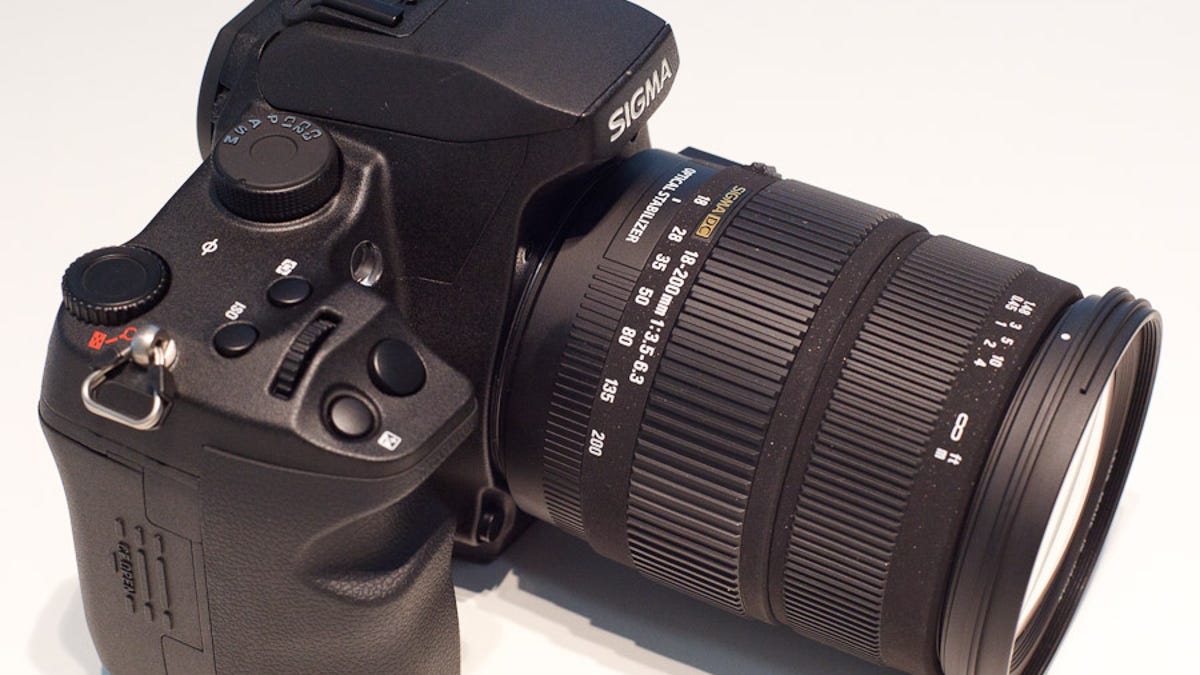Sigma aims SD1 at pro photographers
The $9,700 SLR's Foveon sensor captures three colors per pixel rather than the usual one. Sigma is betting people will pay for that difference.

Sigma has announced it'll ship its SD1 camera in June for $9,700, a price that suggests it's aiming its new flagship SLR almost exclusively at professional photographers.
The Japanese company unveiled the Sigma SD1 last year at the Photokina trade show. The camera embodies the company's aspirations to rise beyond its present role as a maker of third-party lenses into a camera rival to powerhouses such as Nikon and Canon.
The SD1 pricing, though, indicates that Sigma is trying to leapfrog Canon's top-end, $7,500 1Ds Mark III and Nikon's competing $5,900 D3x SLR. The head-to-head rival would be Pentax's 645D, a medium-format model with a sensor larger than the "full-frame" chips in Nikon and Canon's top-end models and much larger than the SD1's.
"The SD1 will carve out a new category in the marketplace by providing high-end photographers with an alternative to very expensive medium-format cameras and digital backs, while offering unrivaled image quality," said Mark Amir-Hamzeh, president of Sigma Corporation of America, in a statement.
Larger sensors offer a better balance of detail, dynamic range, and color, but they cost vastly more to manufacture. Medium-format cameras with large sensors ship in very low volumes for very high prices; Hasselblad's low-end H4D-40, for example, costs $18,000, and lenses add a lot more to the price. It's got a 40-megapixel sensor measuring 33.1x44.2mm. The Pentax 645D's 40-megapixel sensor is 44x33mm, and Nikon and Canon sensors are about 36x24mm.
Apparently, though, Sigma believes the Foveon X3 sensor in its SD1 is a cut above the rest. It measures just 23.5x15.7mm, about the size of sensors on mainstream digital SLRs.
Foveon uses a very different design from most sensors. Each pixel captures three colors--red, green, and blue. Conventional image sensors capture only one color per pixel, and elaborate interpolation algorithms reconstruct each pixel's missing two color values so that images can be displayed, edited, or printed.
Sigma's Foveon design makes it a bit awkward to compare SD1 with rivals such as the 21.1-megapixel Canon 1Ds Mark III and 24.5-megapixel Nikon D3x. The SD1's sensor has resolution of 4,800x3,200 pixels for 15.4 megapixels total--but that's without any interpolation.
So it appears Sigma is betting that customers will do the math and agree with Sigma's 46-megapixel rating--3 colors times 15.4 megapixels--for the SD1. But it's not a free lunch: If you want an actual 46-megapixel image from the camera, you'll have to do the interpolation in software such as Photoshop to get there; with traditional sensor designs the interpolation just happens at an earlier, unavoidable stage in the process.
One notable footnote: The sensor isn't susceptible to moire patterns that can mar photos of fabrics or other scenes with patterns, Sigma said, so no low-pass filter is required. That can improve sharpness.
The earlier Foveon-based cameras from Sigma, though, haven't been commercially successful. And cracking the professional market requires excellent lenses, not just excellent sensors, and the SD1's Sigma lens mount means that existing Canon or Nikon lenses won't mount without an adapter. Last, the SD1 can't shoot video, a feature that's become a major point of competition.
So convincing photographers will take more than a little pixel math.
For those who want more SD1 specs, here are some of what Sigma's providing:
• Autofocus with 11-point cross-type sensors.
• 77-segment evaluative metering, or spot, center, and center-weighted metering.
• ISO range from 100 to 6,400.
• Continuous shooting speed of 5 frames per second at high resolution setting. A memory buffer can accommodate 7 raw images.
• Viewfinder coverage 98 percent horizontally and vertically with 0.95 percent magnification.
• UDMA CompactFlash storage and USB 2.0 interface.
• Shutter rated to 100,000 exposures.
• Removable dust protector for sensor cleaning.
• O-ring seals on buttons to make the camera splashproof.
• Maximum shutter speed 1/8000 sec.
• 460,000-pixel 3-inch LCD screen..
• Dimensions: 145.5mm (W) x 113.5 mm (H) x 80.0 mm (D)
• Weight: 700g

